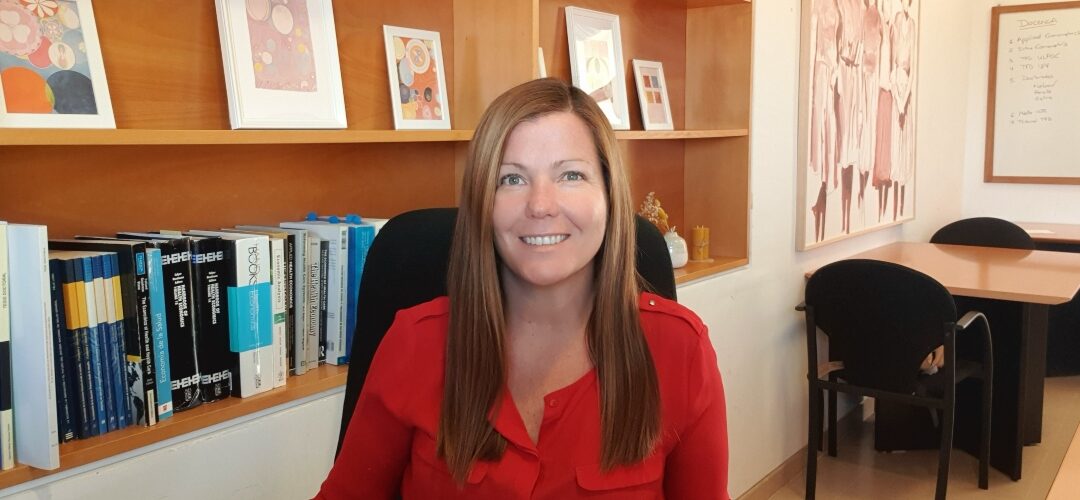Laura Vallejo Torres is a health economist working at the University of Las Palmas de Gran Canaria (ULPG). In IMAGINE, she leads the Work Package in charge of evaluating whether the project is being developed as planned and whether the project meets its main objectives. To do so, she evaluates both the process and the outcomes of the project.
In this interview, we talk to her about her role within the project and highlight aspects of IMAGINE.
How is the evaluation plan being designed in this initial stage of the project? Can you share some of the key indicators that you are considering from the ULPG for the future development of the project?
The evaluation of the process includes implementing and analysing the responses to a series of questionnaires that are sent to participants of the IMAGINE project, at least, monthly. The questionnaires are simple and quick to answer and are aimed at identifying over the course of the study whether the activities are conducted according to plan. So far, the project is running very smoothly!
To evaluate the outcomes of the project we have designed a set of 42 indicators. These indicators will be analysed at the end of the study to identify if the project was able to meet each of its primary and secondary objectives. Key indicators that were constructed are related to the main goals of IMAGINE. They will measure whether, after implementing the interventions, nursing homes were able to increase the number of infection prevention and control elements, and whether they were able to reduce the incidence of antibiotic-treated urinary tract infections and the inappropriate use of antibiotics.
What are the initial challenges that you are identifying, and how are you addressing them in your work package?
IMAGINE is an ambitious project with a long list of primary and secondary objectives. The main challenge at this stage was to define indicators capable of measuring whether all these objectives will be met using the data that is collected in the study. To do this, we held several meetings with many members of the project, and we ended up with a list of 42 indicators. The data will come from differences sources: the APO charts filled by the health care professionals, the infection control and prevention questionnaires filled in by ambassadors at each nursing home, and from the preliminary background information questionnaires answered by the head of the nursing homes. We managed to include in these data collection tools the information required to monitor the achievement of the mains goals of the project.
Given that the project involves different disciplines and collaborators from various points in Europe, what are the benefits and challenges of working in such a diverse environment?
Working with colleagues from different disciplines is always enriching. At every decision, there are aspects that are overlooked by some of us – economists, statisticians – that are pointed out by others – clinicians, nurses, project managers, etc, and viceversa. And having participants from such a large number of countries helps making this project relevant for a wide range of contexts. Questionnaires need to be not only translated but also tailored to particular contexts. And the data analysis will need to be conducted both separately for each country as well as jointly for all the participants of the project. But the efforts are worthy because this allows us to paint a full picture and give us the opportunity of collaborating with people from different parts of the world.
As a professional in the field of Health Economics and Public Policies, what does it mean for you to be part of a project like this?
As a health economist working in academia, I think these types of projects probably represent the best opportunity for our research to have an actual impact on people lives. It is a very fulfilling experience to see a clear translation of our work into improvements on the daily living of health professionals, patients, and their relatives. To be capable from our discipline to contribute to this achievement in collaboration with colleagues coming from so many different backgrounds means a great deal to our team.
What importance do you think the IMAGINE project has in the current context?
Improving the care provided in nursing homes and reducing the need and inappropriate use of antibiotics among the elderly are urgent issues that need to be tackled. From our experience in previous projects, we know that the context of nursing homes is different and requires specific measures. The interventions that work in general practices or in out-of-hours services might not necessarily work in the context of a nursing home where several types of health care professionals take care of their residents. Therefore, the importance of this project is clear: it will develop and evaluate specific interventions targeted to improve the health of vulnerable and frail individuals who are susceptible to frequent and severe infections.
Why do you think it is relevant to allocate public funds for research in projects like this?
IMAGINE is addressing a public health issue with repercussions to the wider society. By reducing infections and the unnecessary use of antibiotics, this project has the potential not only of improving the health of the individuals benefiting directly from the interventions, but also of reducing antimicrobial resistance and public spending on health. The role of public funding is crucial to develop these projects and at the same time public institutions will also be the beneficiaries from the outcomes of this project.

